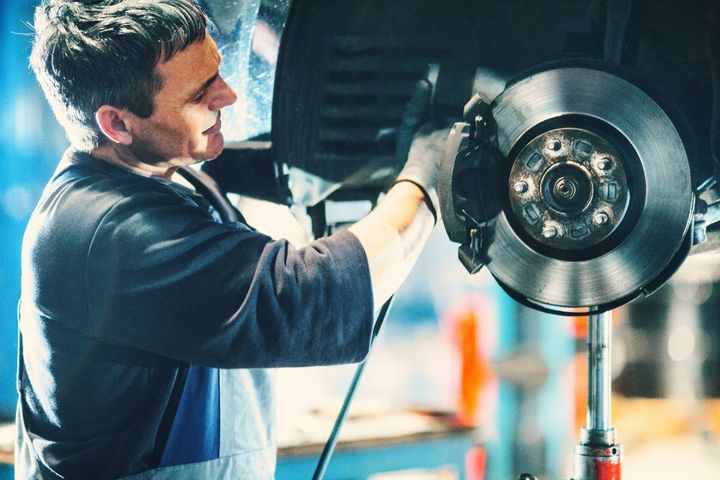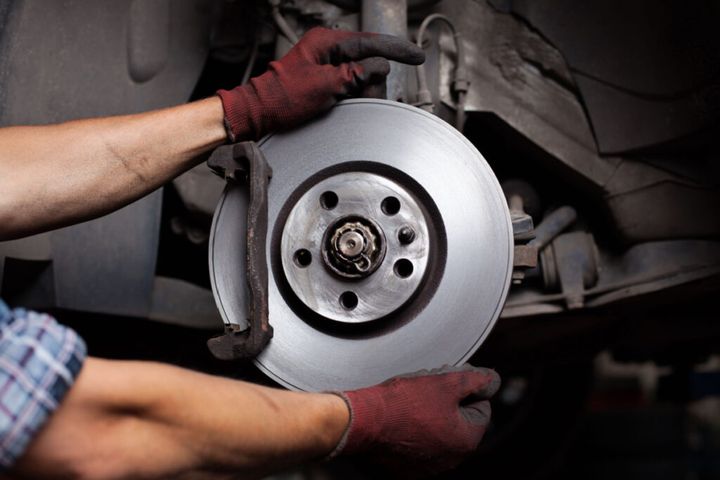


Brakes are a critical safety component in vehicles, responsible for slowing down and stopping the vehicle when needed.
A properly functioning brake system is essential for maintaining control of the vehicle and avoiding accidents, especially in emergency situations.
Brake failure can lead to severe consequences, such as collisions, injuries, and loss of life.
Regular maintenance and inspection of the brake system are crucial to ensure its proper functioning and identify any potential issues before they become safety hazards.

The brake system is a complex and intricate network of components, and any failure within this system can lead to a loss of brake pressure. Here are some of the most common culprits:
| Cause | Description |
|---|---|
| Brake Fluid Leaks | Leaks in the brake lines, calipers, wheel cylinders, or the master cylinder itself can cause a significant loss of brake fluid, resulting in reduced hydraulic pressure throughout the system. These leaks can be caused by various factors, such as worn seals, corrosion, or physical damage to the components. |
| Air in the Brake Lines | Air can enter the brake lines due to low fluid levels or leaks, and this can be a major issue. Air is compressible, which means that when you press the brake pedal, the air compresses instead of transferring the full hydraulic pressure to the brakes. This can lead to a spongy or soft brake pedal feel, reducing your ability to stop effectively. |
| Worn Master Cylinder Seals | The master cylinder is the heart of the brake system, and it's responsible for converting the mechanical force from the brake pedal into hydraulic pressure. Over time, the seals within the master cylinder can wear out, allowing air to enter the system or causing internal fluid leaks. This can lead to a loss of pressure and a sinking or spongy brake pedal feel. |
| Faulty Brake Booster | The brake booster is a crucial component that assists in amplifying the force applied to the brake pedal, making it easier for the driver to apply the brakes. If the brake booster fails, you may experience a hard or stiff brake pedal that requires excessive effort to press, which can be dangerous in emergency situations. |
| Damaged Brake Lines or Hoses | Corrosion, wear, or physical damage to the brake lines or hoses can cause fluid leaks and, consequently, a loss of pressure in the system. These components are subjected to extreme temperatures, road debris, and constant flexing, which can lead to their deterioration over time. |
As a mechanic, diagnosing the root cause of a loss of brake pressure involves a thorough inspection and a systematic approach. Here are the steps I typically follow:
Check the brake fluid level and condition: I start by checking the brake fluid level in the reservoir and inspecting the fluid's condition. Discolored or contaminated fluid can be an indication of a problem.
Visual inspection for leaks: I carefully examine the entire brake system, including the calipers, wheel cylinders, lines, and the master cylinder, looking for any signs of fluid leaks or wetness.
Fluid leaks: Visible fluid on components or ground
Air in the system: Spongy pedal, excessive pedal travel
Master cylinder failure: Sinking pedal, internal leaks
Brake booster failure: Hard pedal, lack of power assist
Damaged lines/hoses: Visible damage, leaks, or corrosion
Evaluate the brake pedal feel: I pay close attention to the feel of the brake pedal when applying the brakes. A spongy or excessively soft pedal can indicate air in the system, while a hard or stiff pedal may point to a faulty brake booster.
Listen for abnormal noises: Any unusual noises, such as hissing or grinding, when applying the brakes can provide valuable clues about the nature of the problem.
Perform a brake system pressure test: In some cases, I may need to conduct a pressure test on the brake system to identify any leaks or pressure drops that are not visually apparent.
Based on the findings from these inspections, I can often pinpoint the specific issue causing the loss of brake pressure.
Once the root cause of the problem has been identified, the next step is to carry out the necessary repairs. Here are the typical repair procedures I follow for various issues:
Locate and repair the leak by replacing seals, hoses, or lines as needed.
Flush the entire brake system to remove any contaminated fluid or debris.
Bleed the brake system following the manufacturer's recommended procedure to remove any air pockets.
Refill the system with fresh, high-quality brake fluid.
If air has entered the brake lines, the solution is to bleed the brake system properly. I follow the manufacturer's specific bleeding procedure, which may involve:
Opening bleeder valves in a specific order
Pumping the brake pedal to expel any trapped air
Checking for any remaining air pockets or leaks
Safely depressurize the brake system to avoid any accidental fluid discharge.
Remove the old master cylinder and inspect it for any signs of damage or wear.
Install the new master cylinder and bench bleed it to remove any air pockets.
Bleed the entire brake system to ensure proper operation.
| Step | Action |
|---|---|
| 1 | Inspect the brake booster for any leaks or damage. |
| 2 | If the booster is faulty, replace it with a new one. |
| 3 | Adjust the pushrod clearance between the booster and the master cylinder according to the manufacturer's specifications. |
Safely depressurize the brake system.
Remove the damaged brake line or hose.
Install the new line or hose, ensuring proper routing and secure connections.
Bleed the brake system to remove any air pockets.
Throughout these repair procedures, I always follow all necessary safety precautions and use only the recommended brake fluid for the specific vehicle. Proper bleeding is crucial to ensure that all air pockets are removed from the system, and I torque all fittings and connections to the specified values.

While repairs are necessary to address the immediate issue, preventing future occurrences of brake pressure loss is equally important. Here are some tips and best practices I recommend:
Check the brake fluid level and condition periodically, as recommended by the manufacturer.
Inspect brake components for wear or damage during routine services, such as brake pad replacements or tire rotations.
Replace the brake fluid as per the manufacturer's recommended intervals, as old or contaminated fluid can contribute to system issues.
Avoid excessive brake usage or riding the brakes, as this can cause premature wear and overheating.
Allow the brakes to cool down after heavy usage, such as descending steep grades or towing heavy loads.
Maintain proper tire pressure and alignment, as improper tire conditions can affect braking performance and component wear.
By following these preventive measures, you can significantly reduce the likelihood of experiencing a loss of brake pressure and ensure the longevity and reliable performance of your vehicle's brake system.
The cost of repairing a loss of brake pressure issue can vary depending on the specific cause and the extent of the repair required. Here are some approximate cost ranges:
| Repair | Cost Range |
|---|---|
| Brake fluid leak repair | $150 - $400 (including parts and labor) |
| Brake bleeding | $80 - $150 (labor cost) |
| Master cylinder replacement | $300 - $600 (including parts and labor) |
| Brake booster replacement | $400 - $800 (including parts and labor) |
| Brake line or hose replacement | $150 - $400 per line/hose (including parts and labor) |
It's important to note that these costs can vary based on factors such as the make and model of your vehicle, the complexity of the repair, and the labor rates in your area. It's always recommended to get a quote from a reputable repair shop before proceeding with any brake repairs.
As an automotive mechanic, I understand the critical importance of maintaining a properly functioning brake system. A loss of brake pressure can be a serious and potentially dangerous issue, but with the right knowledge and expertise, it can be diagnosed and repaired effectively. By following proper maintenance practices, being attentive to any warning signs, and addressing issues promptly, you can ensure the safety and reliability of your vehicle's braking system.
Remember, when it comes to brakes, it's always better to err on the side of caution. If you experience any issues with your brakes or suspect a loss of brake pressure, don't hesitate to have it inspected by a qualified mechanic. Your safety and the safety of others on the road should always be the top priority.
In this comprehensive guide, I've covered the main causes of loss of brake pressure, the diagnostic steps, repair procedures, preventive measures, and cost considerations. By understanding these aspects, you can be better prepared to address this critical issue and maintain the optimal performance of your vehicle's braking system.
The main signs of a brake fluid leak include a low brake fluid level in the reservoir, wetness or fluid stains around brake components, and a spongy or soft brake pedal feel.
Brake fluid should be replaced according to the manufacturer's recommended intervals, typically every 2-3 years or 30,000-40,000 miles.
Yes, if there is a significant amount of air in the brake lines, it can lead to a complete loss of braking ability, which is an extremely dangerous situation.
A spongy or soft brake pedal is usually caused by air in the brake lines or a brake fluid leak, which reduces the hydraulic pressure in the system.
To check for a faulty brake booster, you can observe if the brake pedal feels excessively hard or stiff when applying the brakes, indicating a lack of power assist from the booster.
Yes, corrosion in brake lines can cause leaks or weaknesses, leading to a loss of brake fluid and a subsequent loss of brake pressure.
Bleeding the brake system is the process of removing any trapped air pockets from the brake lines and components, ensuring proper hydraulic pressure and brake operation.
No, worn brake pads themselves do not directly cause a loss of brake pressure, but they can be an indication of other underlying issues or neglected maintenance.
No, it is never safe to drive with a loss of brake pressure, as it significantly reduces your ability to stop the vehicle effectively, putting you and others at risk.
Maintaining proper tire pressure and alignment can help prevent excessive wear on brake components and ensure optimal braking performance, reducing the likelihood of brake pressure issues.

Sarah isn't your average gearhead. With a double major in Mechanical Engineering and Automotive Technology, she dived straight into the world of car repair. After 15 years of turning wrenches at dealerships and independent shops, Sarah joined MICDOT to share her expertise and passion for making cars run like new. Her in-depth knowledge and knack for explaining complex issues in simple terms make her a valuable asset to our team.



